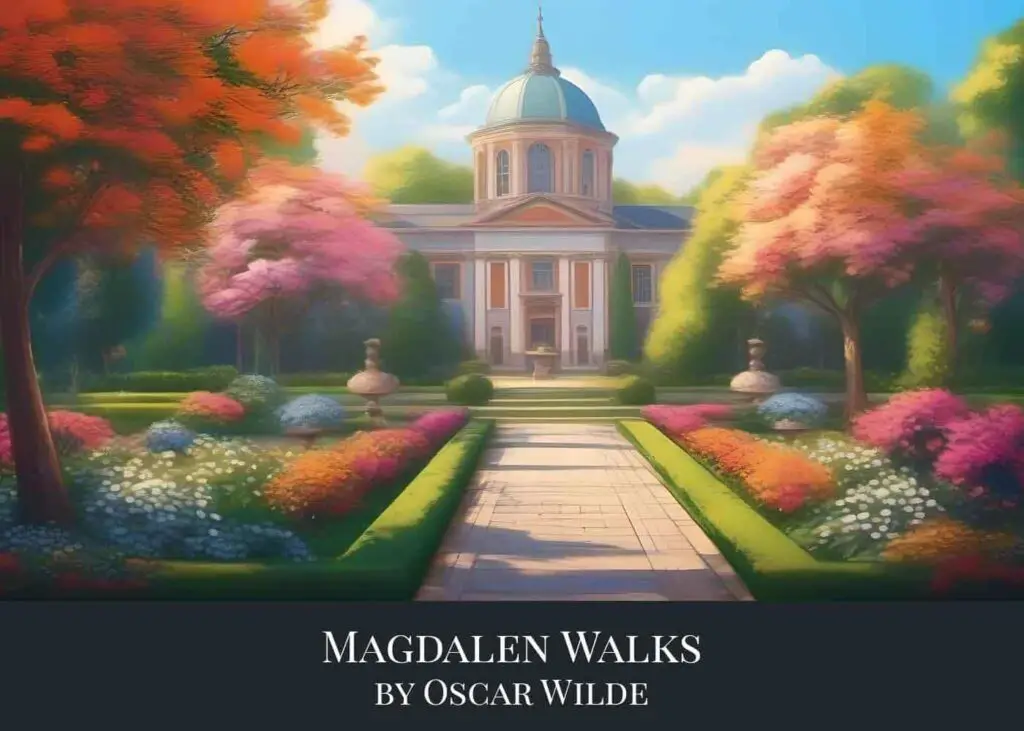
Magdalen Walks by Oscar Wilde
“Magdalen Walks” is a lyrical poem by Irish wit, poet, and dramatist Oscar Wilde that vividly captures the essence of spring as witnessed in the garden of Magdalen College, Oxford. This piece is a celebration of nature’s rejuvenating power, with a particular focus on the sights and sounds that herald the arrival of the new season. “Magdalen Walks,” as well as other poetic works by Wilde, are included in his first poetry collection titled Poems. For those interested in exploring this and other poems by Wilde, an online version of Poems is available at PageVio.
1. The Poem
The little white clouds are racing over the sky,
And the fields are strewn with the gold of the flower of March,
The daffodil breaks under foot, and the tasselled larch
Sways and swings as the thrush goes hurrying by.
A delicate odour is borne on the wings of the morning breeze,
The odour of deep wet grass, and of brown new-furrowed earth,
The birds are singing for joy of the Spring’s glad birth,
Hopping from branch to branch on the rocking trees.
And all the woods are alive with the murmur and sound of Spring,
And the rose-bud breaks into pink on the climbing briar,
And the crocus-bed is a quivering moon of fire
Girdled round with the belt of an amethyst ring.
And the plane to the pine-tree is whispering some tale of love
Till it rustles with laughter and tosses its mantle of green,
And the gloom of the wych-elm’s hollow is lit with the iris sheen
Of the burnished rainbow throat and the silver breast of a dove.
See! the lark starts up from his bed in the meadow there,
Breaking the gossamer threads and the nets of dew,
And flashing adown the river, a flame of blue!
The kingfisher flies like an arrow, and wounds the air.
Download Magdalen Walks Poster
Size: 8″ x 12″ (2:3 ratio)
Format: PDF
Copyright information: For personal use only
Note: Actual poster background color is white. For the sample poster, the background is made gray for illustration purpose.
2. Magdalen Walks Analysis
This poem is an evocative depiction of a vibrant spring landscape, rich with movement, color, and life. The imagery in the poem draws heavily on the senses, particularly sight and smell, to bring the scene to vivid life. Here is a breakdown of the poem, stanza by stanza:
First Stanza
The poem opens with a description of small, white clouds racing across the sky, suggesting a brisk, lively day. The fields are described as “strewn with the gold of the flower of March,” likely referring to the daffodils that are a common harbinger of spring. The image of the daffodil being crushed underfoot and the larch tree with its tassels swaying adds to the sense of vitality and the slightly reckless abundance of the season. A thrush, a type of bird known for its song, is mentioned as moving quickly, adding to the energetic atmosphere.
Second Stanza
The second stanza shifts to the scents of the season: the “deep wet grass” and “brown new-furrowed earth,” which are very evocative of a fresh, damp morning in early spring. This is a time when the earth is being plowed for new planting, adding to the sense of renewal. The birds’ singing and their active movement from branch to branch further emphasize the joy and liveliness associated with the awakening of the natural world in spring.
Third Stanza
In the third stanza, the focus is on the woods, described as alive with the “murmur and sound of Spring.” The rosebud and the crocus are presented in vivid colors, with the crocus bed compared to a “quivering moon of fire,” which is a striking image of its bright yellow or gold blooms. The “belt of an amethyst ring” could refer to other flowers encircling the crocus bed, possibly purple in color, like amethysts.
Fourth Stanza
The fourth stanza personifies the trees, with the plane tree whispering a tale of love to the pine, suggesting the intimate connection between living things in the spring. There is laughter and movement, and even the darker places, like the hollow of the wych-elm, are lit up with the iridescent colors of a dove, which introduces a sense of harmony and beauty found even in the dimmer corners of the woods.
Fifth Stanza
The final stanza captures the sudden, energetic motion of a lark as it breaks from its resting place in the meadow, disrupting the delicate dew in the process. The kingfisher, with its bright blue plumage, is likened to a swift, darting flame, reinforcing the theme of vitality and the vigorous activity that defines the season.
Overall, the poem celebrates the revival of nature in the spring, filled with life, colors, and scents. Wilde uses the motifs of movement—racing clouds, breaking flowers, hurrying birds, rustling trees—and vibrant colors—gold, pink, green, silver—to emphasize the dynamism and renewal inherent in spring. It’s a time of both delicate beauty and rampant growth, a time when all of nature seems to be waking up and bursting into life.
3. Conclusion
If you find “Magdalen Walks” enjoyable, you might want to take a look at this list of poems penned by Oscar Wilde.